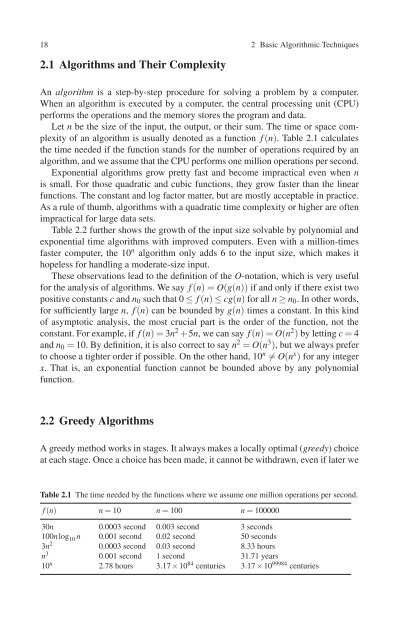You also want an ePaper? Increase the reach of your titles
YUMPU automatically turns print PDFs into web optimized ePapers that Google loves.
18 2 Basic Algorithmic Techniques<br />
2.1 Algorithms and Their Complexity<br />
An algorithm is a step-by-step procedure for solving a problem by a computer.<br />
When an algorithm is executed by a computer, the central processing unit (CPU)<br />
performs the operations and the memory stores the program and data.<br />
Let n be the size of the input, the output, or their sum. The time or space complexity<br />
of an algorithm is usually denoted as a function f (n). Table 2.1 calculates<br />
the time needed if the function stands for the number of operations required by an<br />
algorithm, and we assume that the CPU performs one million operations per second.<br />
Exponential algorithms grow pretty fast and become impractical even when n<br />
is small. For those quadratic and cubic functions, they grow faster than the linear<br />
functions. The constant and log factor matter, but are mostly acceptable in practice.<br />
As a rule of thumb, algorithms with a quadratic time complexity or higher are often<br />
impractical for large data sets.<br />
Table 2.2 further shows the growth of the input size solvable by polynomial and<br />
exponential time algorithms with improved computers. Even with a million-times<br />
faster computer, the 10 n algorithm only adds 6 to the input size, which makes it<br />
hopeless for handling a moderate-size input.<br />
These observations lead to the definition of the O-notation, which is very useful<br />
for the analysis of algorithms. We say f (n)=O(g(n)) if and only if there exist two<br />
positive constants c and n 0 such that 0 ≤ f (n) ≤ cg(n) for all n ≥ n 0 . In other words,<br />
for sufficiently large n, f (n) can be bounded by g(n) times a constant. In this kind<br />
of asymptotic analysis, the most crucial part is the order of the function, not the<br />
constant. For example, if f (n)=3n 2 +5n, we can say f (n)=O(n 2 ) by letting c = 4<br />
and n 0 = 10. By definition, it is also correct to say n 2 = O(n 3 ), but we always prefer<br />
to choose a tighter order if possible. On the other hand, 10 n ≠ O(n x ) for any integer<br />
x. That is, an exponential function cannot be bounded above by any polynomial<br />
function.<br />
2.2 Greedy Algorithms<br />
A greedy method works in stages. It always makes a locally optimal (greedy) choice<br />
at each stage. Once a choice has been made, it cannot be withdrawn, even if later we<br />
Table 2.1 The time needed by the functions where we assume one million operations per second.<br />
f (n) n = 10 n = 100 n = 100000<br />
30n 0.0003 second 0.003 second 3 seconds<br />
100nlog 10 n 0.001 second 0.02 second 50 seconds<br />
3n 2 0.0003 second 0.03 second 8.33 hours<br />
n 3 0.001 second 1 second 31.71 years<br />
10 n 2.78 hours 3.17 × 10 84 centuries 3.17 × 10 99984 centuries

















